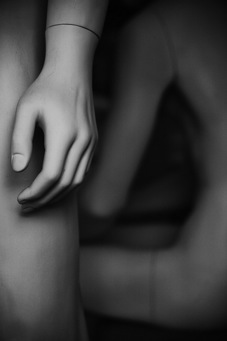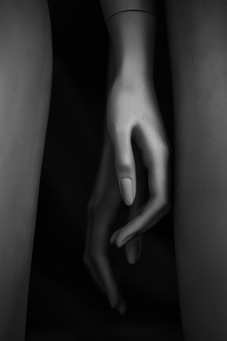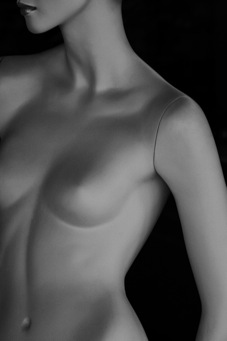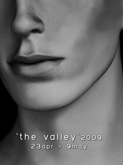THE UNCANNY VALLEY
catalogue essay for
‘The Uncanny Valley’
an exhibition of new works
by Olga Marcus
Gallery139
6 March to 31 May 2009
"The body is not merely matter but a continuous and incessant materialising of possibilities" Judith Butler

The Uncanny Valley refers to the sudden drop in a graphed line of positive human reaction to humanoid forms as they approach indistinguishibility from the real. The verisimilitude of the copy highlights its lack, its not quite humanness and it becomes uncanny. Empathy and identification become revulsion and dread.

Oscillating between convincing reality and the patently unreal, these images discomfit as they undermine our conviction that we can always distinguish the real from the copy. Schooled to accept artifice as nature, perfection as norm rather than genetic fluke, we're set up for a fall here. The artist's careful isolation and framing of details; the sensual line of a mouth, waist or arm and the cool tonality recall whole lineages of portraiture (including Mapplethorpe's of Lisa Lyon) drawing on this to seduce us into belief in this apparently real perfection. A perfection that comes instantly undone as joins, labels, dust and marks are revealed.
This discomfort is not simply the unease of category confusion but because these bodies are only sketchy suggestions of an ideal, their lack of detail is as disturbing as their uncanny regularity. These are not bodies designed to be seen for themselves but as blanks for our projections. To be gazed at but not seen.

But as lack is the start of all desire, in making them flawed copies they become instead an open space of empathy and desire, their lack a channel for longing.
Shot through the window of a showroom where they were arranged without apparent care, they seem to be self possessed and in the midst of things. Finding relationships; lines of sight that intersect, hands that yearn toward each other without touching, bodies in tense proximity, the artist shows us these as bodies in moments of nascent desire, in a process of becoming. Once seen for themselves, our gaze is robbed of the power to objectify and they become independent of the projections of our looking.

And this is the fear, not that humanoids look like us, not that the manikin, the Golem will come to life but that they surpass us. The fear that impels Deckard in Blade Runner to hunt down the replicants is that they live more intensely, more humanly than he. Deckard fails to learn that while he needs to replicants to assert his humanity and he hunts to do this, they don't need him to measure their humanity against.
In Olga Marcus's cool images of these poised moments of yearning, these others unsettle and disturb in their self possession, their refusal to be only projection and in their simple refusal to be us.
Jemima Kemp
Gallery139 catalogue essay

catalogue essay for
‘The Uncanny Valley’
an exhibition of new works
by Olga Marcus
Gallery139
6 March to 31 May 2009
"The body is not merely matter but a continuous and incessant materialising of possibilities" Judith Butler

The Uncanny Valley refers to the sudden drop in a graphed line of positive human reaction to humanoid forms as they approach indistinguishibility from the real. The verisimilitude of the copy highlights its lack, its not quite humanness and it becomes uncanny. Empathy and identification become revulsion and dread.

Oscillating between convincing reality and the patently unreal, these images discomfit as they undermine our conviction that we can always distinguish the real from the copy. Schooled to accept artifice as nature, perfection as norm rather than genetic fluke, we're set up for a fall here. The artist's careful isolation and framing of details; the sensual line of a mouth, waist or arm and the cool tonality recall whole lineages of portraiture (including Mapplethorpe's of Lisa Lyon) drawing on this to seduce us into belief in this apparently real perfection. A perfection that comes instantly undone as joins, labels, dust and marks are revealed.
This discomfort is not simply the unease of category confusion but because these bodies are only sketchy suggestions of an ideal, their lack of detail is as disturbing as their uncanny regularity. These are not bodies designed to be seen for themselves but as blanks for our projections. To be gazed at but not seen.

But as lack is the start of all desire, in making them flawed copies they become instead an open space of empathy and desire, their lack a channel for longing.
Shot through the window of a showroom where they were arranged without apparent care, they seem to be self possessed and in the midst of things. Finding relationships; lines of sight that intersect, hands that yearn toward each other without touching, bodies in tense proximity, the artist shows us these as bodies in moments of nascent desire, in a process of becoming. Once seen for themselves, our gaze is robbed of the power to objectify and they become independent of the projections of our looking.

And this is the fear, not that humanoids look like us, not that the manikin, the Golem will come to life but that they surpass us. The fear that impels Deckard in Blade Runner to hunt down the replicants is that they live more intensely, more humanly than he. Deckard fails to learn that while he needs to replicants to assert his humanity and he hunts to do this, they don't need him to measure their humanity against.
In Olga Marcus's cool images of these poised moments of yearning, these others unsettle and disturb in their self possession, their refusal to be only projection and in their simple refusal to be us.
Jemima Kemp
Gallery139 catalogue essay
